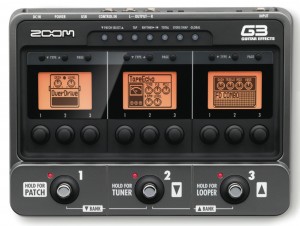
A Few Things about Programming Patches for Your MultiFX Device
A number of the licensees for my Digitech RP patch sets have told me that they’ve tried and given up on programming the device, because it’s just so hard to make their own patches. (Some of them say that programming the RP makes them appreciate how much I’ve put into designing these sounds, for which I thank them.)
I think that in fact it takes a lot of time and focused experimentation to learn how to make one of these boxes sound really great, but there are some easy tricks you can do to get more out of your amp modeler/multiFX box with your own sounds. Here are a few of my favorites for Digitech RPs; all of these tips work on other multiFX boxes too.
1) Find one basic amp setup that works, and build lots of FX around it.
The hardest part of setting up a sound is getting the basic amp/cab/EQ setup working. If you’ve got a great basic setup, you can hang lots of cool stuff on it. So work first on getting the basics down, then try that basic sound with every effect you’ve got. If you’ve got my patch set, try stripping the FX off a patch you like, and see what the amp/cab/EQ looks like; then use that as a starting point for FX variations.

Some amped-up patches sound great without any FX, but sound too distorted when the FX go on. Not to worry. Just turn the GAIN control down to smooth out the tone. If that’s not the right stuff, try changing the Cabinet model, especially if you can change from a small-speaker configuration to a larger one.
2) Copy the FX setups you like from one patch to another.
If it works on one amp, it might very well work on another. Delay and reverb settings are especially portable, and can really transform a sound.
3) Put the expression pedal to work.
The expression pedal is terrifically useful for changing the sound. You can assign it to control volume, or wah, or FX mix, or EQ level, or delay level/time/repeats, or anything else the box is set up to do. It’s criminally negligent not to assign that pedal to something, especially because it’s easy to do. Put the pedal into edit mode, select EXPRESSION, scroll through the parameters until you see something you want to control with the pedal, set the minimum and maximum levels, and save the patch. Now the pedal makes things move in real time. Heavy.
Related Posts
Leave a Reply
You must be logged in to post a comment.
WHAT’S NEW
Categories
- Audio/Video
- Blog
- Blue Future
- Digitech RP Tricks and Tips
- Discography, CDs, Projects, Info, Notes
- Featured Video
- For the Beginner
- Gallery
- Hunter's Effects
- Hunter's Music
- Huntersounds for Fender Mustang
- Meet the Pros
- More Video
- MPH: Maw/Preston/Hunter
- My Three Big Contributions
- Player's Resources
- Pro Tips & Techniques
- Recommended Artists & Recordings
- Recommended Gear
- Recorded Performances
- Reviews, Interviews, Testimonials
- The Lucky One
- Uncategorized
- Upcoming Performances
- Zoom G3 Tips and Tricks